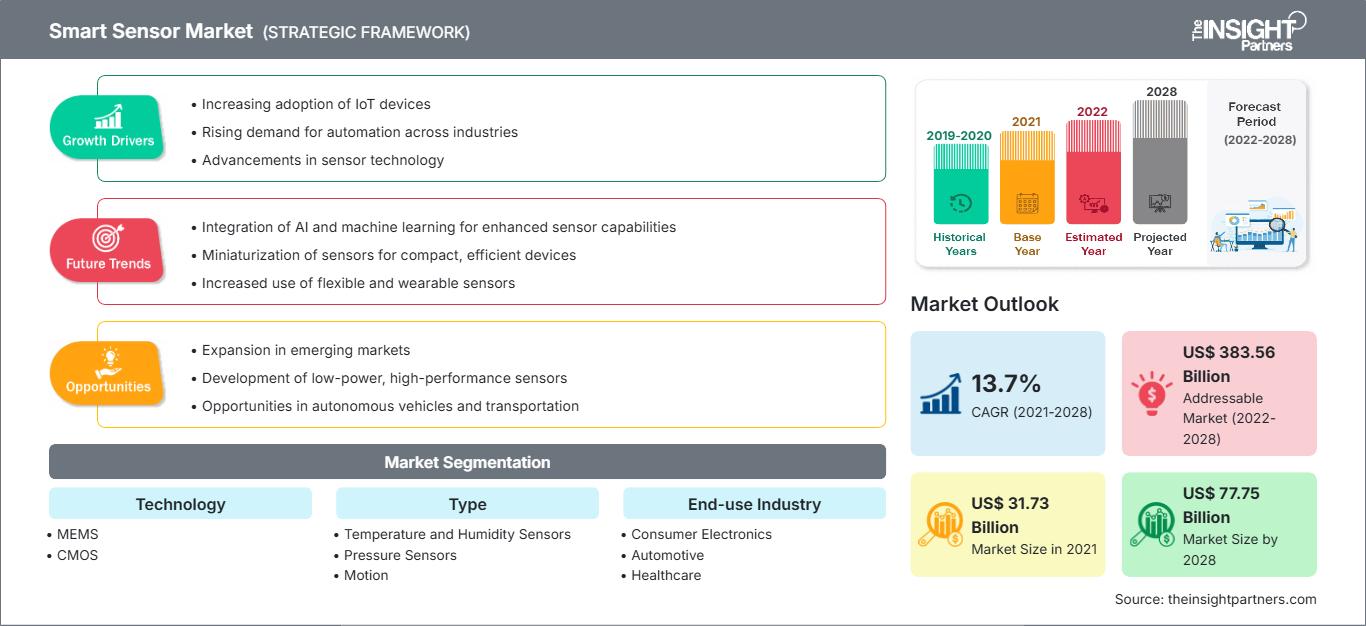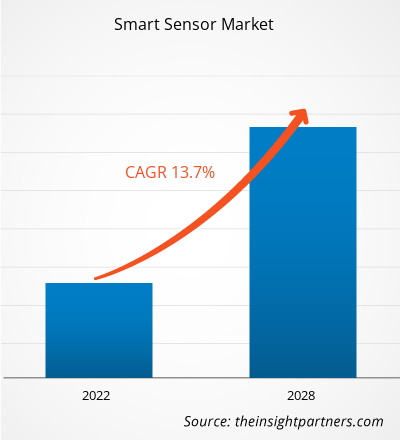스마트 센서 시장은 2021년 317억 3,110만 달러에서 2028년 777억 4,760만 달러로 성장할 것으로 예상되며, 2021년부터 2028년까지 연평균 성장률 13.7%로 성장할 것으로 예상됩니다.
스마트 센서는 기존 센서보다 빠르고 정확합니다. 또한 기존 센서보다 크기가 작고 전력 소모도 적습니다. 지난 몇 년 동안 IoT 기반 기기 및 가전제품에 스마트 센서 기술을 적용하고 항공우주 및 방위, 자동차, 바이오메디컬 및 헬스케어, 산업 자동화, 빌딩 자동화, 가전제품, 교육, 로봇공학, 농업 및 운송 산업에 적용하는 것이 큰 관심을 불러일으켰습니다. 다양한 애플리케이션에서 스마트 센서 사용이 증가하는 것은 스마트 센서 시장 규모를 확대하는 핵심 요인입니다.
안전 및 보안에 대한 우려가 커짐에 따라 가전제품의 스마트 센서 수요가 증가하고 있으며, 이는 스마트 센서 시장에 영향을 미치고 있습니다. 홈 오토메이션에는 야간 투시 IR 센서, 사운드 센서 또는 마이크, 스마트 변기 등 다양한 센서가 사용됩니다. 기업들은 자동 청소, 자동 물내림, 탱크 누수 모니터링, 누수 방지, 건강 모니터링 등 다양한 기능을 스마트 센서에 통합하고 있습니다. 조명과 환풍기는 적외선 또는 모션 센서를 사용하는 자동 시스템으로 제어할 수 있습니다.
또한, 변화하는 라이프스타일과 새로운 현대적 생활 수준에 따라 홈 오토메이션 기능이 통합된 모듈식 주방에 대한 수요가 기하급수적으로 증가하여 스마트 센서 시장에 긍정적인 영향을 미치고 있습니다. 제조업체들은 진동, 주방 소음, 조명, 가스, 온도, 열, 전자기 온도 및 소음을 모니터링하는 합성 센서 기반 장치를 개발하고 있으며, 이는 스마트 센서 시장 규모를 확대하고 있습니다. 예를 들어, 아날로그 디바이스(Analog Devices, Inc.)는 HMC1126 GaAs pHEMT 센서를 제공합니다. 400MHz~52GHz 범위에서 작동하는 저잡음 증폭기로, 마이크로파 무선, 초소형 개구단말(VSAT), 테스트 장비, 5G 통신 등 다양한 분야에 사용됩니다.
이 보고서의 일부, 국가 수준 분석, Excel 데이터 팩을 포함하여 모든 보고서에 대한 사용자 정의를 무료로 받을 수 있을 뿐만 아니라 스타트업 및 대학을 위한 훌륭한 제안 및 할인을 이용할 수 있습니다
스마트 센서 시장: 전략적 통찰력

-
이 보고서의 주요 주요 시장 동향을 확인하세요.이 무료 샘플에는 시장 동향부터 추정 및 예측에 이르기까지 데이터 분석이 포함됩니다.
스마트 센서 기술은 스마트폰과 웨어러블 기기의 급속한 기술 발전을 이끌었습니다. 자동차 제조업체들은 안전성과 편의성을 향상시키기 위해 스마트 센서에 대한 요구가 점점 더 커지고 있습니다. 스마트 센서가 장착된 보안 장치를 모니터링하고 제어하기 위해 무선 기술을 사용하는 것이 점점 더 보편화되고 있습니다. COVID-19 사태 속에서 스마트 센서 기반 웨어러블 기기에 대한 수요 급증, 친환경 건축 건설에 대한 정부의 지속적인 지원, 그리고 예측 유지보수는 스마트 센서 시장 참여자들에게 수익성 있는 기회를 제공하고 있습니다.
스마트폰 보급률 증가는 스마트 센서 시장 성장을 크게 촉진해 왔습니다. 스마트 센서에는 동작, 위치, 주변광, 가속도계, 자이로스코프와 같은 널리 사용되는 센서가 포함됩니다. 전자파 흡수율(SAR) 센서는 스마트폰, 태블릿, 노트북의 5G sub-6/4G/Wi-Fi와 같은 다양한 무선 기술의 연결성을 향상시킵니다. 선도적인 반도체 공급업체인 SEMTECH는 스마트폰, 노트북, 태블릿, 웨어러블 기기 등 다양한 애플리케이션에 사용할 수 있는 PerSeTM Connect, PerSe Connect Pro, PerSe Control 센서를 제공합니다. 많은 기업들이 단일 패키지에 마이크로컨트롤러를 결합한 새롭고 진보된 스마트 센서를 개발하고 있습니다. AI(인공지능) 및 IoT와 같은 최신 기술은 이러한 결합을 소형 패키지에 구현할 수 있도록 지원합니다. 예를 들어, Bosch Sensortec의 BHA250은 2.2 x 2.2 x 0.95mm³ 패키지에 32비트 마이크로컨트롤러와 14비트 가속도 센서를 결합할 수 있습니다. 또한, TE Connectivity는 작은 공간에 기능을 담기 위해 센서와 커넥터를 통합했습니다. 이러한 스마트 센서 기술의 발전은 스마트 센서 시장 성장에 긍정적인 영향을 미치고 있습니다. 스마트 음료 자판기, 스마트 홈 자동화 시스템, 간편 컴퓨터, 알렉사와 같은 디지털 비서, 그리고 웨어러블 기기 등 가전제품 산업의 성장과 함께 스마트 센서 시장의 스마트 센서 수요가 증가했습니다. 노트북, 스마트폰, TV와 같은 기존 소비자 제품은 소비자들이 웨어러블, 음성 인식 스마트 스피커, 스마트 홈 기기 등 새롭고 떠오르는 제품을 지속적으로 채택함에 따라 기대치를 뛰어넘고 있습니다. 여러 연구에 따르면 향후 몇 년 안에 수천억 대의 IoT 기기가 인터넷에 연결될 것으로 예상되며, 이는 스마트 센서 시장에 큰 영향을 미칠 것입니다. COVID-19는 도시 정부가 새로운 현실에 적응함에 따라 도시의 회복력과 디지털 혁신 전략 의제를 주도하고 있습니다. COVID-19 팬데믹이 스마트 센서 시장에 미치는 영향
COVID-19의 출현으로 원격 환자 모니터링을 위한 디지털 인프라 활용의 필요성이 더욱 부각되었습니다. 현재 바이러스 검사 및 백신 개발이 더딘 상황에서, 웨어러블 센서가 도움이 될 수 있는 개인 및 인구 건강의 더욱 강력한 질병 탐지 및 모니터링에 대한 필요성이 더욱 커지고 있음이 확인되었습니다. 이 기술의 유용성은 생리적 지표를 일상생활 및 인간의 활동과 연관시키는 데 사용되어 왔지만, COVID-19 발생 예측에는 여전히 적용이 필요합니다.
에너지 절약 기기에 대한 수요 증가는 북미 스마트 센서 시장에서 스마트 센서에 대한 시장 수요를 견인하고 있습니다. 변화하는 환경 속에서 에너지 효율적인 장비와 제품이 필요함에 따라 기업들은 에너지 효율적인 에너지 절약 장비로 전환하고 있습니다. 또한, 정부의 엄격한 규제가 완화됨에 따라 다양한 산업 분야에서 스마트 센서 시장의 센서 수요가 증가했으며, 이러한 규제는 자동화 산업에서 점차 중요해지고 있습니다. 또한, 자동차 부문의 센서 수요는 자동차의 평균 중량을 줄이려는 욕구에 의해 주도되고 있습니다. 경량 자동차는 연비와 에너지 최적화에 모두 도움이 됩니다.
스마트 센서 시장The Insight Partners의 분석가들은 예측 기간 동안 스마트 센서 시장에 영향을 미치는 지역별 동향과 요인을 면밀히 분석했습니다. 이 섹션에서는 북미, 유럽, 아시아 태평양, 중동 및 아프리카, 그리고 중남미 지역의 스마트 센서 시장 세분화 및 지역별 분포도 살펴봅니다.
스마트 센서 시장 보고서 범위
| 보고서 속성 | 세부 |
|---|---|
| 시장 규모 2021 | US$ 31.73 Billion |
| 시장규모별 2028 | US$ 77.75 Billion |
| 글로벌 CAGR (2021 - 2028) | 13.7% |
| 이전 데이터 | 2019-2020 |
| 예측 기간 | 2022-2028 |
| 다루는 세그먼트 |
By 기술
|
| 포함된 지역 및 국가 |
북미
|
| 시장 선도 기업 및 주요 회사 프로필 |
|
스마트 센서 시장 참여자 밀도: 비즈니스 역학에 미치는 영향 이해
스마트 센서 시장은 소비자 선호도 변화, 기술 발전, 그리고 제품 이점에 대한 인식 제고 등의 요인으로 인한 최종 사용자 수요 증가에 힘입어 빠르게 성장하고 있습니다. 수요가 증가함에 따라 기업들은 제품 라인업을 확장하고, 소비자 니즈를 충족하기 위한 혁신을 추진하며, 새로운 트렌드를 적극 활용하고 있으며, 이는 시장 성장을 더욱 가속화하고 있습니다.

- 을 얻으세요 스마트 센서 시장 주요 주요 플레이어 개요
스마트 센서 시장 세분화
기술 기반으로 스마트 센서 시장은 MEMS, CMOS 및 기타로 세분화됩니다. 2021년에는 MEMS 부문이 시장을 주도했습니다. 유형 기반으로 스마트 센서 시장은 온도 및 습도 센서, 압력 센서, 모션 센서, 위치 센서 및 기타로 세분화됩니다. 2021년에는 온도 및 습도 센서 부문이 가장 큰 시장 점유율을 차지했습니다. 최종 사용 산업 기반으로 스마트 센서 시장은 가전, 자동차, 의료, 제조, 소매 및 기타로 세분화됩니다.
아날로그 디바이스, 인피니언 테크놀로지스, ST마이크로일렉트로닉스, TE 커넥티비티, 마이크로칩 테크놀로지스, NXP 세미컨덕터, 지멘스 AG, ABB, 로버트 보쉬, 허니웰 인터내셔널 등이 주요 스마트 센서 시장 참여 기업입니다. 이 외에도 글로벌 스마트 센서 시장의 전반적인 역학을 파악하기 위해 몇몇 다른 업체를 분석했습니다.
- 과거 분석(2년), 기준 연도, CAGR을 포함한 예측(7년)
- PEST 및 SWOT 분석
- 시장 규모 가치/거래량 - 글로벌, 지역, 국가
- 산업 및 경쟁 환경
- Excel 데이터세트
최근 보고서
관련 보고서
사용 후기
구매 이유
- 정보에 기반한 의사 결정
- 시장 역학 이해
- 경쟁 분석
- 고객 인사이트
- 시장 예측
- 위험 완화
- 전략 기획
- 투자 타당성 분석
- 신흥 시장 파악
- 마케팅 전략 강화
- 운영 효율성 향상
- 규제 동향에 발맞춰 대응






















 무료 샘플 받기 - 스마트 센서 시장
무료 샘플 받기 - 스마트 센서 시장